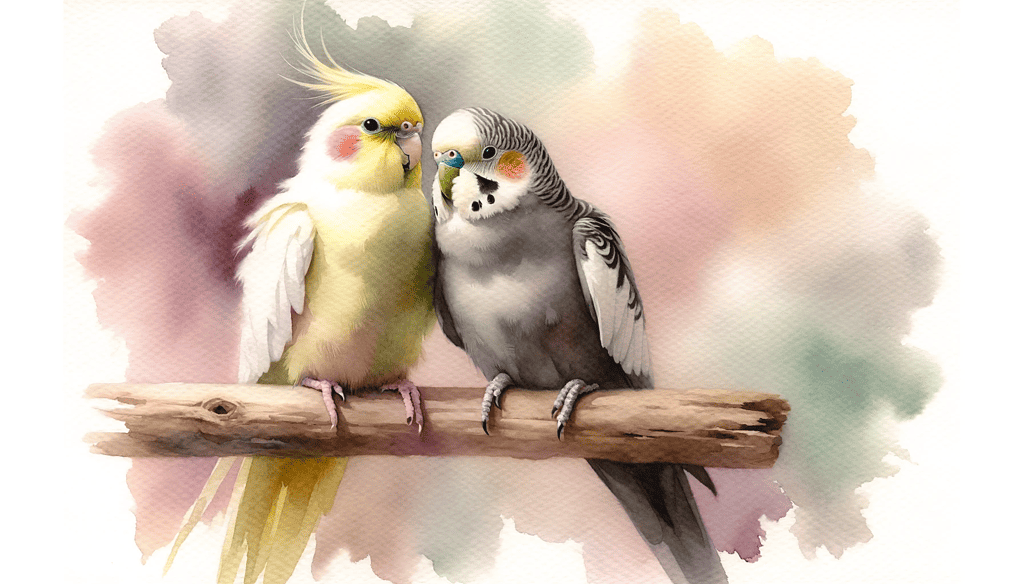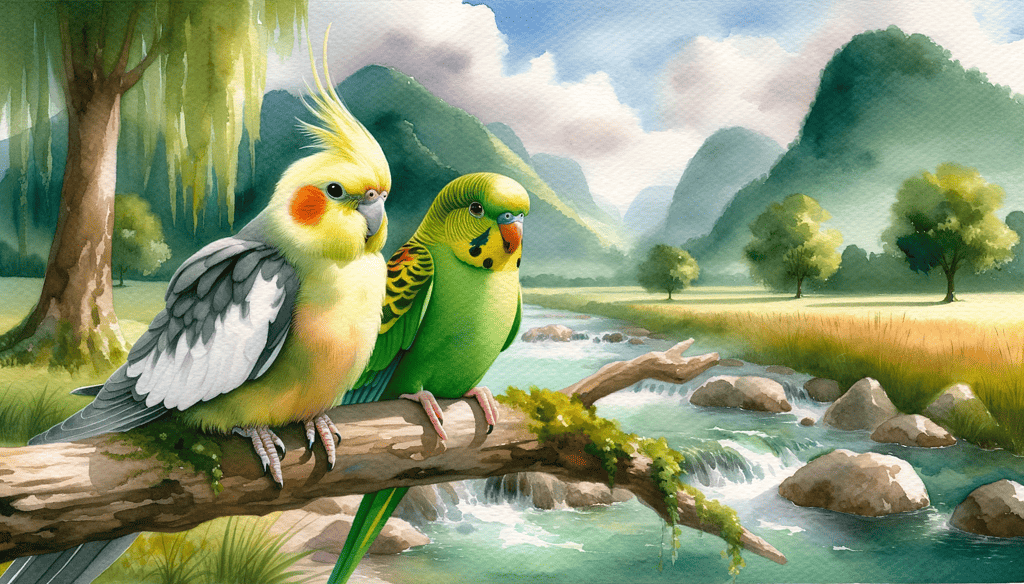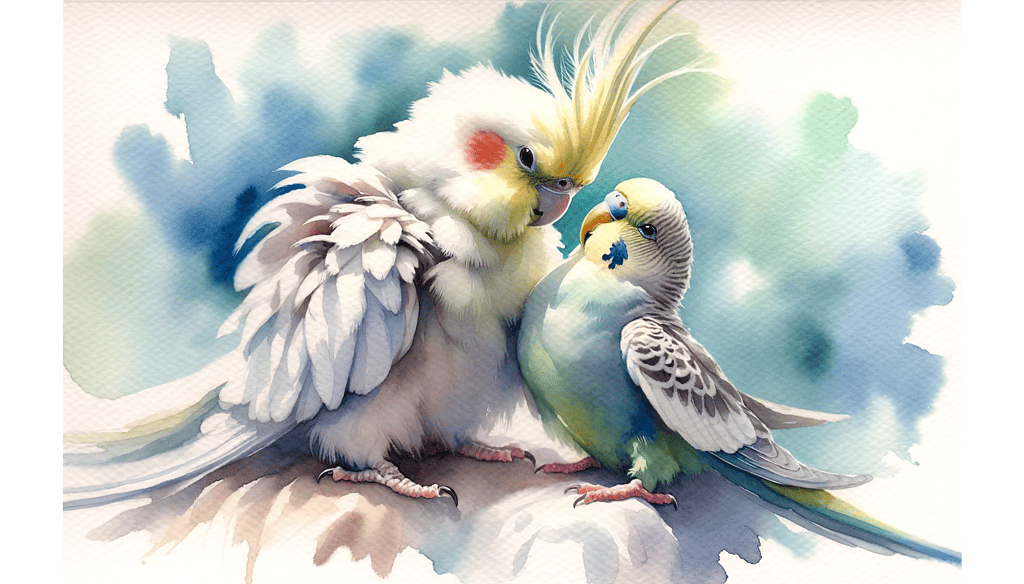
Birds have always been a symbol of freedom and beauty, with their vibrant colors and melodic tunes. Among the vast avian kingdom, cockatiels and parakeets stand out as two of the most popular pet birds. Their captivating personalities and striking appearances have made them favorites among bird enthusiasts. But have you ever wondered about the dynamics between these two species?
As a general rule, cockatiels and parakeets can coexist harmoniously, but understanding their behaviors, needs, and interactions is crucial for cohabitation. Both birds, native to Australia, have their own set of characteristics that make them distinct yet compatible under the right conditions.
Curious to know more? Dive in to unravel the intricate relationship between these feathered friends and discover how to house them together for a harmonious birdie bond.
Cockatiels: An Overview
Hailing from the vast landscapes of Australia, cockatiels have made quite a name for themselves in the pet world. Their charm is undeniable, and their presence is always a delight.
Origin and Natural Habitat
Australia is home to these beauties. They thrive in the wild, often found in wetlands, scrublands, and bushlands. Their adaptability to various environments is truly commendable.
Physical characteristics
- Color variations: Cockatiels come in a range of colors, from classic grey to vibrant lutinos and even pied variations.
- Size: Typically, they measure around 13 inches from head to tail. A decent size for a pet bird, if you ask me!
- Unique markings: One of their most distinctive features is the crest on their head, which they raise and lower based on their mood. It’s like a little mood indicator!
Behavior and temperament
Cockatiels are known for their loving and playful nature. They seek attention and are often seen whistling or mimicking sounds. Their sociable demeanor makes them great companions. However, they can be a tad sensitive, so it’s crucial to approach them with care and patience.
Common health issues and care needs
- Nutritional deficiencies: A balanced diet is essential. Ensure they get a mix of seeds, fruits, and veggies.
- Respiratory issues: Good ventilation and clean surroundings can help prevent this.
- Feather plucking: This can be due to stress or boredom. Toys and interactions can help alleviate this behavior.
- Parasites: Regular check-ups and maintaining cleanliness can keep these at bay.
- Injuries: Given their active nature, they might get minor injuries. Always ensure their environment is safe.
Parakeets: An Overview
Parakeets, often referred to as budgies, are another gem from Australia. Their petite size and vibrant colors make them a favorite among many.
Origin and Natural Habitat
Just like cockatiels, parakeets call Australia their home. They’re often seen in woodlands and grasslands, chirping away and living their best life.
Physical characteristics
- Color variations: These little birds come in a plethora of colors, from greens and blues to yellows and even whites.
- Size: They’re smaller than cockatiels, measuring around 7-8 inches.
- Unique markings: Their barred patterns and bright cheek patches are quite the sight!
Behavior and temperament
Parakeets are lively and full of energy. They’re curious creatures, always on the lookout for something interesting. They’re social and love to chatter, making them quite the entertainers.
Common health issues and care needs
- Tumors: Regular check-ups can help in early detection.
- Psittacosis: It’s a bacterial infection that requires immediate attention.
- Mites and lice: Keeping their environment clean can prevent these pests.
- Nutritional deficiencies: A varied diet is key. Seeds, fruits, and veggies should be part of their meals.
- Injuries: Due to their curious nature, they might get into little mishaps. Ensure their surroundings are safe.
Now, I know what you’re thinking. “Can these two birds coexist?” Well, let’s delve into that in the next sections. But for now, I hope this gives you a clearer picture of these two fantastic birds. Remember, understanding them is the first step to ensuring they live a happy and healthy life under your care.
Comparing Cockatiels and Parakeets

When it comes to comparing these two avian wonders, there’s a lot to unpack. Both birds have their unique quirks and characteristics, but how do they stack up against each other?
Size and appearance
At first glance, the size difference is evident. Cockatiels, with their 13-inch stature, are notably larger than the 7-8 inch parakeets. While cockatiels flaunt a crest that’s a mood indicator, parakeets boast vibrant cheek patches and barred patterns. Their appearances, though distinct, are equally captivating.
Lifespan and health
| Bird | Average Lifespan | Common Health Issues | Preventive Care |
| Cockatiel | 10-15 years | Nutritional deficiencies, Respiratory issues | Balanced diet, Clean habitat |
| Parakeet | 7-10 years | Tumors, Psittacosis | Regular check-ups, Varied diet |
Vocalization and communication
Both birds are quite the chatterboxes. Cockatiels are known for their whistles and mimicking abilities. They can pick up tunes and even replicate certain sounds around them. Parakeets, on the other hand, are incessant chirpers. They love to communicate, and with proper training, they can even pick up words and phrases. Their vocal nature makes them lively additions to any household.
Social needs and compatibility
Here’s where things get interesting. Both birds are social creatures. They thrive on interaction, be it with their kind or with humans. However, their dynamics when put together can be a mixed bag. While many cockatiels and parakeets get along just fine, their personalities play a significant role. Parakeets, despite their smaller size, can be quite assertive, sometimes overshadowing the more docile cockatiels. It’s essential to monitor their interactions, especially in the beginning, to ensure a harmonious coexistence.
In my experience, introducing them gradually and ensuring they have separate spaces can make a world of difference. It’s like introducing two strangers. They might hit it off instantly, or they might need some time to warm up to each other. But with patience and understanding, they can become the best of pals.
Can Cockatiels and Parakeets Live Together?

Cockatiels and parakeets, two of the most beloved pet parrots in the US, both hail from the sunburned landscapes of Australia. With their shared origin, they naturally have a lot in common, from their personalities to their habitats. But can they really coexist under the same roof, or more precisely, within the same cage?
In the wild, these birds have been known to coexist peacefully. They often search for seeds and plants, sometimes even in mixed groups. Their natural behavior in the wild suggests that they can live together without much fuss. However, when it comes to domestic settings, there are a few factors you should consider.
- Compatibility: Cockatiels are generally playful and sociable, rarely showing signs of aggression or territorial behavior. On the flip side, parakeets, while also affectionate and social, can be a tad more assertive. Their smaller stature doesn’t stop them from being the boss sometimes. But, in most cases, their contrasting personalities complement each other, leading to a harmonious relationship.
- Size Matters: Cockatiels are notably larger than parakeets. This size difference can be an advantage as it reduces the likelihood of serious conflicts. However, it’s essential to ensure that the cage is spacious enough to accommodate both birds comfortably.
- Territorial Behavior: Like all birds, both cockatiels and parakeets can become territorial, especially during breeding seasons. It’s crucial to provide them with enough space and separate nesting areas to prevent potential conflicts.
- Dietary Needs: While they share many dietary preferences, there are subtle differences. For instance, cockatiels might require a slightly higher fat content in their diet. It’s essential to cater to each bird’s specific dietary needs to ensure their health and well-being.
- Personality Traits: Every bird, just like humans, has its unique personality. Some might be more laid-back, while others might be more assertive. It’s essential to observe and understand each bird’s personality before deciding to house them together.
I remember a time when I introduced a young cockatiel to an older parakeet. At first, the parakeet, despite being smaller, tried to assert dominance. But over time, with careful observation and intervention, they became inseparable pals. They would chirp together, share food, and even groom each other. It was a heartwarming sight!
Why Cockatiels and Parakeets Can Be Kept Together
The shared Australian origin of cockatiels and parakeets plays a significant role in their compatibility. In their natural habitat, they often forage together in mixed groups, searching for seeds and plants. Their shared love for being part of a flock and their exceptional flying skills make them quite compatible.
However, it’s essential to be aware of their territorial behaviors. Both birds can become territorial, especially when protecting a partner, nesting place, or even a favorite toy. While they usually prefer to avoid conflicts, it’s crucial to provide them with enough space to ensure peace.
Introducing Cockatiels and Parakeets for the First Time
Introducing two birds, especially from different species, is a delicate dance. It’s like setting up two friends on a blind date; you hope they’ll hit it off, but there’s always a bit of uncertainty. Over the years, I’ve had the privilege of introducing numerous cockatiels and parakeets, and while each experience is unique, there are some tried-and-true steps that can help ensure a smooth introduction.
- Gradual Introduction: Never just throw the two birds together and hope for the best. Start by placing their cages in the same room but at a distance from each other. This allows them to get used to each other’s presence without any direct interaction. Over a week or two, gradually move the cages closer together, observing their reactions.
- Neutral Territory: Once they seem comfortable with each other’s presence, allow them to meet in a neutral space outside their cages. This ensures neither bird feels territorial. A play stand or a tabletop works great for this.
- Monitor Their Behavior: Keep a close eye on them during their first few interactions. Look for signs of aggression or fear. If either bird seems stressed, it might be a good idea to give them more time before the next meeting.
- Dietary Considerations: Both birds have similar dietary needs, but there are subtle differences.
- Cockatiels: They thrive on a variety of seeds, especially grass seeds, fruits, berries, and vegetation.
- Parakeets: Their diet includes fruits, nectar from flowers, insects, and their larvae.
- Ensure that each bird has its own food bowl to prevent potential conflicts. Introducing a shared treat during their meetings can also be a great icebreaker!
- Shared Activities: Birds, like humans, bond over shared activities. Introducing toys or play activities during their meetings can help them bond. Just ensure the toys are suitable for both birds.
Housing Cockatiels and Parakeets Together

As we delve deeper into the world of cockatiels and parakeets, it’s essential to understand the nuances of housing these birds together. Their shared origin and similar needs might make it seem straightforward, but there’s more to it than meets the eye.
Cage Requirements
The cage is more than just a home for your birds; it’s their sanctuary. Ensuring they have ample space and the right environment is crucial for their well-being.
Importance of a Spacious Cage
A spacious cage is not just a luxury; it’s a necessity, especially when housing two birds of different species. It provides them with enough room to fly, play, and have their own personal space. A cramped cage can lead to stress, territorial disputes, and even health issues.
Cage Design Considerations Based on Physical Attributes
Different birds have different needs, and their physical attributes play a significant role in determining the ideal cage design. Here’s a comparative table to help you understand the requirements:
| Attribute | Cockatiel | Parakeet |
| Cage Size | 24 x 24 x 30 inches | 24″x 24″x 30″ |
| Bar Spacing | Between 0.5 and 5/8 of an inch | 1/2″ to 5/8″ |
| Material | Durable, non-toxic metals | Durable, non-toxic metals |
Nesting Considerations During Breeding Seasons
Breeding season can be a sensitive time for both cockatiels and parakeets. They become more territorial and protective of their nests. It’s essential to ensure each bird has a safe and comfortable nesting spot. If they’re sharing a cage, consider providing separate nesting boxes to avoid conflicts.
Temperaments
While both cockatiels and parakeets are social and affectionate birds, their personalities can be quite contrasting.
Cockatiels:
- Loving and playful
- Seek attention and enjoy being the center of attraction
- Generally mellow and less aggressive
Parakeets:
- Quieter and more reserved
- Non-destructive and easy to care for
- Can be assertive and bossy, despite their smaller size
Understanding these behavioral traits is crucial when housing them together. Their contrasting personalities can either make them the best of friends or lead to occasional squabbles. It’s essential to monitor their interactions, especially during the initial days, to ensure they’re getting along.
Dietary Needs
Both cockatiels and parakeets have specific dietary requirements, with some shared needs and a few differences.
Cockatiels:
- Thrive on a variety of seeds, especially grass seeds
- Love fruits, berries, and vegetation
Parakeets:
- Prefer fruits and nectar from flowers
- Occasionally enjoy insects and their larvae
While they share many dietary preferences, it’s essential to cater to their unique needs. Ensure each bird has its food bowl to prevent potential conflicts.
Accessories
Toys play a crucial role in a bird’s life, providing them with entertainment, mental stimulation, and physical exercise.
Recommended Toys:
- Shredding toys made from paper, seagrass, coconut, and softwood
- Swings, bells, and ropes
- Toys that encourage foraging and problem-solving
Items to Avoid:
- Toys with small or delicate components that can be swallowed
- Toys with sharp edges or parts that can cause injury
Remember, the key to a harmonious coexistence between cockatiels and parakeets lies in understanding their needs, personalities, and preferences. With the right approach, these two beautiful birds can share a home and bring endless joy to their owners.
Important Things to Consider When Housing Them Together
When you’re thinking about housing cockatiels and parakeets together, it’s not just about throwing them into a cage and hoping for the best. There’s a bit more nuance to it. Let’s dive into some of the essential considerations.
- Providing Separate Homes Initially: It’s always a good idea to start by giving each bird its own space. This allows them to get used to their new environment without the added stress of a new roommate. Place their cages in the same room but not right next to each other. This gives them a chance to observe and get accustomed to each other from a safe distance.
- Ensuring Separate Food and Water Bowls: Just like humans, birds can be a bit possessive about their food. To prevent any potential squabbles, make sure each bird has its own set of food and water bowls.
- Observing Their Interactions: Birds, like people, have their own personalities. Some might be more outgoing, while others might be shy or even aggressive. It’s crucial to keep a close eye on them, especially during their initial interactions, to ensure they’re getting along.
- Understanding Individual Personalities: Remember, each bird is unique. While it’s rare, there’s always a chance that one might be more territorial or aggressive than usual. It’s essential to understand and respect their individual personalities to ensure a harmonious living situation.
Final Thoughts
Bringing together cockatiels and parakeets can be a delightful experience, filled with chirps, songs, and playful antics. However, like any relationship, it requires understanding, patience, and a bit of work. From my years of experience, I can tell you that the joy of seeing these birds interact and form bonds is truly unparalleled. It’s a testament to the beauty of nature and the incredible world of birds. I encourage you to share your experiences and thoughts in the comments below. And if you found this article insightful, don’t hesitate to share it with fellow bird enthusiasts. Every bit of knowledge helps in ensuring our feathered friends lead happy, healthy lives.
Frequently Asked Questions
What birds can be kept with cockatiels?
Cockatiels can coexist harmoniously with budgerigars, turquoise parrots, and red-crowned parakeets in the same aviary, as long as breeding is avoided. However, it’s essential to note that they communicate in entirely different languages.
Are cockatiels nice to parakeets?
Absolutely! Cockatiels are generally friendly towards parakeets. Both species are popular pets worldwide and are known for their friendliness not only towards fellow birds but also humans.
Can cockatiels and budgies understand each other?
Not exactly. While they might pick up on each other’s body language and cues, they don’t understand each other’s vocal communications due to their distinct languages.
